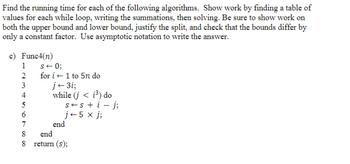
Database System Concepts
7th Edition
ISBN: 9780078022159
Author: Abraham Silberschatz Professor, Henry F. Korth, S. Sudarshan
Publisher: McGraw-Hill Education
expand_more
expand_more
format_list_bulleted
Concept explainers
Question

Transcribed Image Text:Find the running time for each of the following algorithms. Show work by finding a table of
values for each while loop, writing the summations, then solving. Be sure to show work on
both the upper bound and lower bound, justify the split, and check that the bounds differ by
only a constant factor. Use asymptotic notation to write the answer.
c) Func4(n)
1
2
3
4
567∞∞
s = 0;
for i 1 to 5n do
8
j← 3i;
while (j < i³) do
s+ s + i - j;
j+5 x j;
end
end
8 return (s);
Expert Solution
This question has been solved!
Explore an expertly crafted, step-by-step solution for a thorough understanding of key concepts.
Step by stepSolved in 3 steps

Knowledge Booster
Learn more about
Need a deep-dive on the concept behind this application? Look no further. Learn more about this topic, computer-science and related others by exploring similar questions and additional content below.Similar questions
- please explain how to do this and explain the answer.arrow_forwardFor each of the following algorithm in pseudo-code, indicate the time efficiency using BigTheta (Θ) notation. You need to 1) identify the basic operation, and 2) justify your results by doing summation or listing and solving the recurrence relation of T(n), which is the number of basic operations.It is your decision to make on the method you use to solve the recurrence. Question 1) for i = 3 to n dofor j = 1 to i doa[i][j]= 0; Question 2) Algorithm f(n): if n==1 return 1; return 2*f(n-1)+ n*n*n;arrow_forwardConsider a sequence of integers defined by the following recurrence: f(0) = 0, f(1) = 1, and f(i) = f(i – 1) + f([i/2]) for i > 2. We would like to compute f(n) using DP. If we use bottom-up approach, what is the running time? Explain how you obtained your answer. (Assume every basic operation such as plus takes O(1) time as usual.) Give a pseudo-code for a top-down approach with memoization.arrow_forward
- Please solve using iterative method: Solve the following recurrences and compute the asymptotic upper bounds. Assume that T(n) is a constant for sufficiently small n. Make your bounds as tight as possible. a. T(n) = T(n − 2) + √n b.T(n) = 2T(n − 1) + carrow_forward4. Give an analysis of the running time (Big-Oh will do). sum = 0; for( i = 0; i < n; ++i ) for( j = 0; j < n * n; ++j ) ++sum;arrow_forward1. Determine the running time of the following algorithm. Write summations to represent loops and solve using bounding. Be sure to show work on both the upper bound and lower bound, justify the split, and check that the bounds differ by only a constant factor. Use asymptotic notation to write the answer. Func1(n) 1 2 3 4 5 6 7 8 9 10 11 S← 0; for i ←n to n² do for j← 1 to i do for k9n to 10n² do for mi to k end end end return (s); end s+s + i- j + k −m;arrow_forward
- 4. Practice with the iteration method. We have already had a recurrence relation ofan algorithm, which is T(n) = 4T(n/2) + n log n. We know T(1) ≤ c.(a) Solve this recurrence relation, i.e., express it as T(n) = O(f(n)), by using the iteration method.Answer:(b) Prove, by using mathematical induction, that the iteration rule you have observed in 4(a) is correct and you have solved the recurrence relation correctly. [Hint: You can write out the general form of T(n) at the iteration step t, and prove that this form is correct for any iteration step t by using mathematical induction.Then by finding out the eventual number of t and substituting it into your generalform of T(n), you get the O(·) notation of T(n).]arrow_forwardHow do I do (K+1)? Please use step by step simply pleasearrow_forwardTime comp.arrow_forward
- What do I do for (K + 1)? Please explain as best as possiblearrow_forwardA recursive algorithm is applied to some data A = (a₁,..., am) where m≥ 2. The running time T is characterised using the following recurrence equations: T(2) = c when the size of A is 2 T(m) = T(m-1) + 2c otherwise Determine the running time complexity of this algorithm.arrow_forward
arrow_back_ios
arrow_forward_ios
Recommended textbooks for you
 Database System ConceptsComputer ScienceISBN:9780078022159Author:Abraham Silberschatz Professor, Henry F. Korth, S. SudarshanPublisher:McGraw-Hill Education
Database System ConceptsComputer ScienceISBN:9780078022159Author:Abraham Silberschatz Professor, Henry F. Korth, S. SudarshanPublisher:McGraw-Hill Education Starting Out with Python (4th Edition)Computer ScienceISBN:9780134444321Author:Tony GaddisPublisher:PEARSON
Starting Out with Python (4th Edition)Computer ScienceISBN:9780134444321Author:Tony GaddisPublisher:PEARSON Digital Fundamentals (11th Edition)Computer ScienceISBN:9780132737968Author:Thomas L. FloydPublisher:PEARSON
Digital Fundamentals (11th Edition)Computer ScienceISBN:9780132737968Author:Thomas L. FloydPublisher:PEARSON C How to Program (8th Edition)Computer ScienceISBN:9780133976892Author:Paul J. Deitel, Harvey DeitelPublisher:PEARSON
C How to Program (8th Edition)Computer ScienceISBN:9780133976892Author:Paul J. Deitel, Harvey DeitelPublisher:PEARSON Database Systems: Design, Implementation, & Manag...Computer ScienceISBN:9781337627900Author:Carlos Coronel, Steven MorrisPublisher:Cengage Learning
Database Systems: Design, Implementation, & Manag...Computer ScienceISBN:9781337627900Author:Carlos Coronel, Steven MorrisPublisher:Cengage Learning Programmable Logic ControllersComputer ScienceISBN:9780073373843Author:Frank D. PetruzellaPublisher:McGraw-Hill Education
Programmable Logic ControllersComputer ScienceISBN:9780073373843Author:Frank D. PetruzellaPublisher:McGraw-Hill Education

Database System Concepts
Computer Science
ISBN:9780078022159
Author:Abraham Silberschatz Professor, Henry F. Korth, S. Sudarshan
Publisher:McGraw-Hill Education

Starting Out with Python (4th Edition)
Computer Science
ISBN:9780134444321
Author:Tony Gaddis
Publisher:PEARSON

Digital Fundamentals (11th Edition)
Computer Science
ISBN:9780132737968
Author:Thomas L. Floyd
Publisher:PEARSON

C How to Program (8th Edition)
Computer Science
ISBN:9780133976892
Author:Paul J. Deitel, Harvey Deitel
Publisher:PEARSON

Database Systems: Design, Implementation, & Manag...
Computer Science
ISBN:9781337627900
Author:Carlos Coronel, Steven Morris
Publisher:Cengage Learning

Programmable Logic Controllers
Computer Science
ISBN:9780073373843
Author:Frank D. Petruzella
Publisher:McGraw-Hill Education